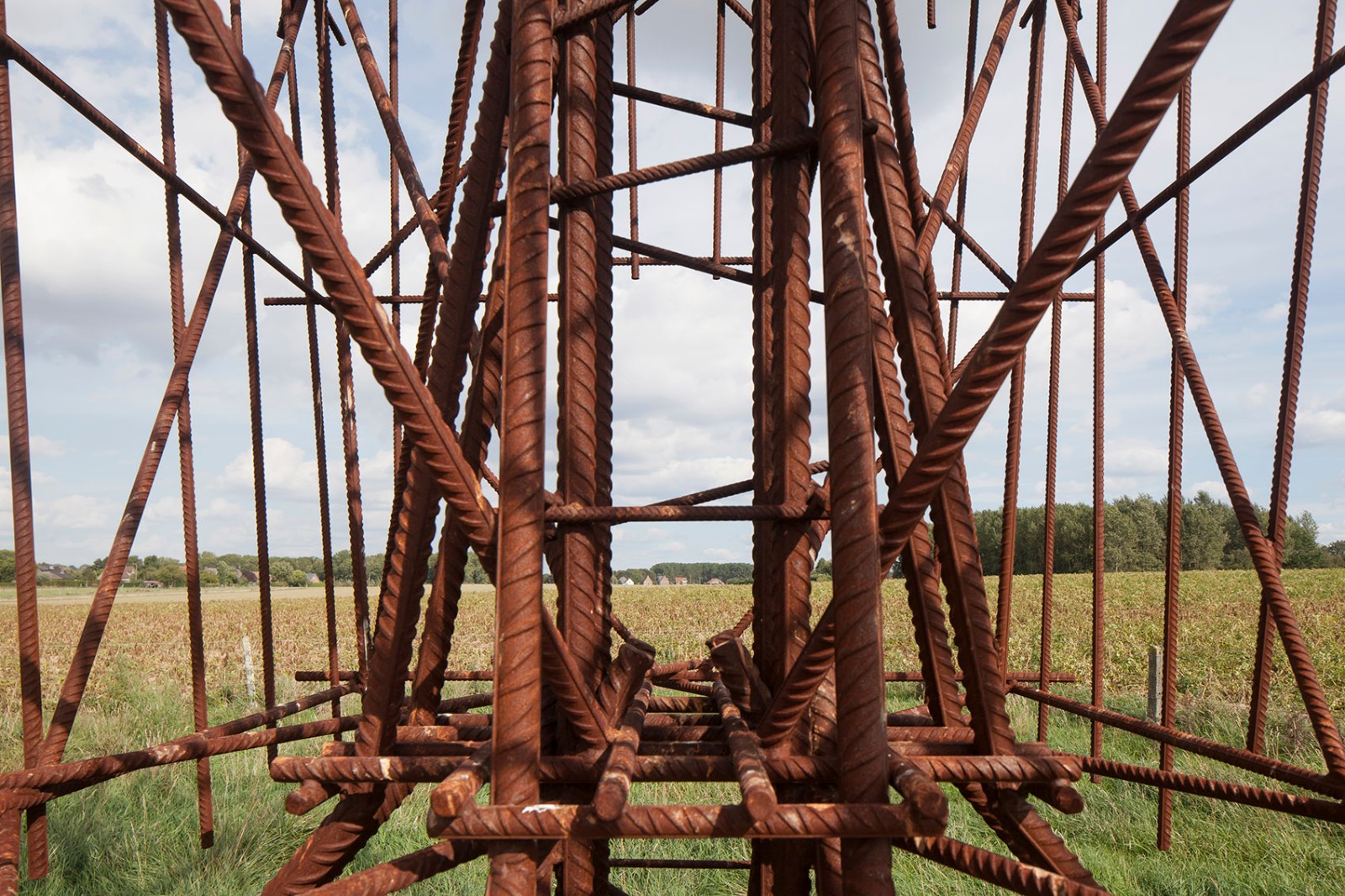比利时“风车研习”装置设计 | Gijs Van Vaerenbergh
-
项目名称:比利时“风车研习”装置设计
-
项目地点:比利时
-
设计公司:
-
图片来源:Johnny Umans
建筑师和艺术家二人组Gijs Van Vaerenbergh近期完成了一件由加强钢筋组成的新作品,其位于Dilbeek开阔的景观中,这里曾激发了画家勃鲁盖尔的创作灵感。据说,勃鲁盖尔曾多次从布鲁塞尔旅行到乡村,用速写记录下这里典型的弗兰芒景观。Saint Anne教堂、Sint-Ger-trudis-Pede的水车,以及一些其他物体,被认为是这位老画家绘画和雕塑作品中的主要意象。弗兰芒风车便是画家作品中反复出现的元素之一,可以在1564年的画作《受难之路》之中看到。“风车研习”装置以勃鲁盖尔经常设置在Dilbeek景观中的风车象征为基础,自由重建了这一不久之前的地标。
Architect and artist duo Gijs Van Vaerenbergh recently created a new work made of reinforcing steel situated in the open landscape of Dilbeek, the region that inspired painter Pieter Bruegel the Elder. It is said that Bruegel travelled several times from Brussels to the countryside to sketch views of this typical Flemish landscape. The Church of Saint Anne or the Watermill at Sint-Gertrudis-Pede, among others, are said to feature in the paintings and engravings of the Old Master. Another recurring element is the Flemish post mill, which can be seen in for instance The Procession to Calvary from 1564. Study for a Windmill is based on this typology that Bruegel often used and places the windmill back into the Dilbeek landscape. Gijs Van Vaerenbergh freely recreates this landmark of yesteryear.


▲装置远景,distanced view of the installation ©Johnny Umans

▲装置外观,由钢筋制成的风车,external view of the installation composed of steel ©Johnny Umans
钢铁绘制的线条 A line drawing in steel
Gijs Van Vaerenbergh将绘画的自然性和短暂性与建筑的可触性和纪念性结合在了一起。他们设计的风车如同具象化的线稿,矗立在起伏的大地之上。雕塑大小是传统风车的一半,由加强钢筋制成,如同速写时交错的线条。从远处看去,“风车研习”装置几乎消失不见。当人们走近时,会发现它伫立在开阔的天空下,随着观者视角的变化而移动。
Gijs Van Vaerenbergh brings together the spontaneity and ephemerality of drawing and the tangible and monumental nature of architecture. Their windmill, like a materialised line drawing, rises above the undulating landscape. The sculpture is a ½ scale model of a post mill, made out of reinforcing steel, evoking a sketchy interplay of lines. Seen from a distance, the work seems to disappear almost entirely. Up close, Study for a Windmill stands out against the wide open skies and shifts according to the spectator’s point of view.


▲不同角度下风车的变化,the mill shifts according to the observation angle ©Johnny Umans



▲钢筋如同绘画线条,steel like sketch lines ©Johnny Umans
再阐释 Reinterpretation
这件作品体现了建筑师和艺术家使用参照物的特别方式:它不仅是艺术史上的参照,也暗示了场地的内涵。借此,他们进一步用这件空间装置的全部将场地本身的特质展现到人们面前。为了达到这个目的,他们以新的方式诠释了基础的建筑和艺术形象,如门、桥、穹顶、以及本项目中的风车等。“风车研习”不仅是对勃鲁盖尔的风车的致敬,还展现了它对当地丰饶景观的重要意义,重现了这一消失已久的醒目地标。
This work evinces the duo’s characteristic play with references; not only art-historical references, but also allusions to the meaning of a place. In doing so, they further develop their oeuvre of spatial installations that bring to the fore the site-specific qualities of a place. They achieve this through the introduction of elementary architectural and artistic typologies – such as the gate, the bridge, the dome, and in this case, the mill – which are interpreted in novel ways. Study for a Windmill is not only a tribute to Bruegel’s mill, but also a reference to its significance in the region’s productive landscape, a recognisable landmark that has long since disappeared.


▲细部,details
Location: In the field along the Ganzeveldweg between Doylijkstraat and Lenniksebaan, 1701 Dilbeek (coordinates: 50°49’17,8 “N 4°13’42,2 “E)
Commissioned by: De Blik van Bruegel
Photos: © Johnny Umans
版权声明:本文版权归原作者所有,如有侵犯您的权益请及时联系,我们将第一时间删除。
投稿邮箱:info@landscape.cn
















